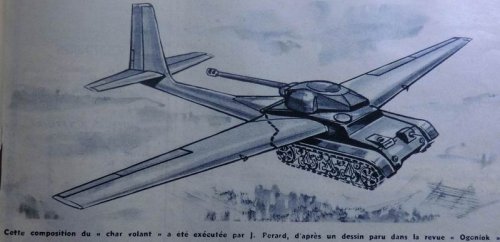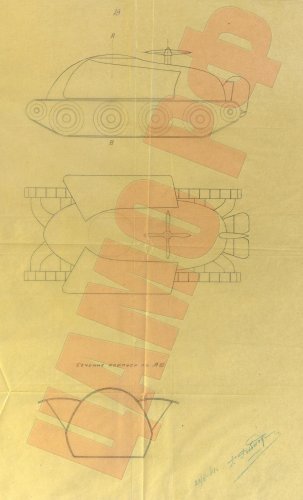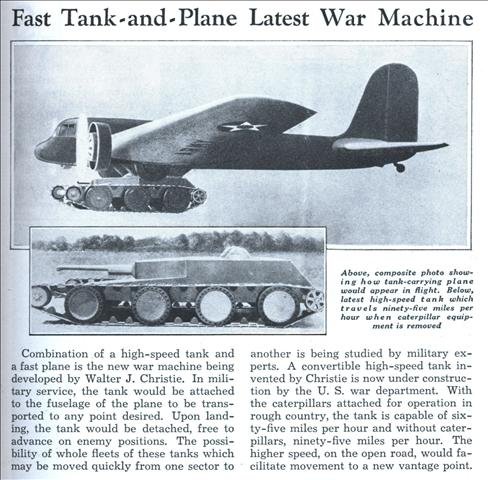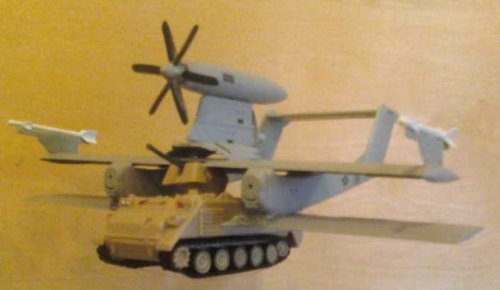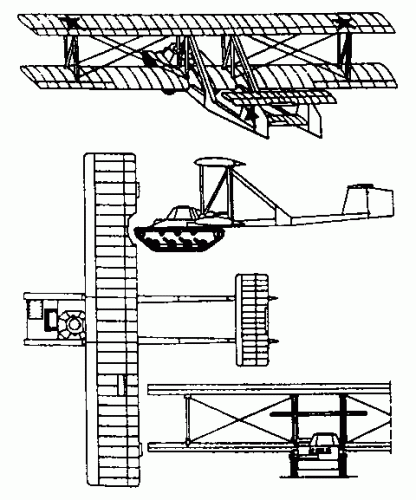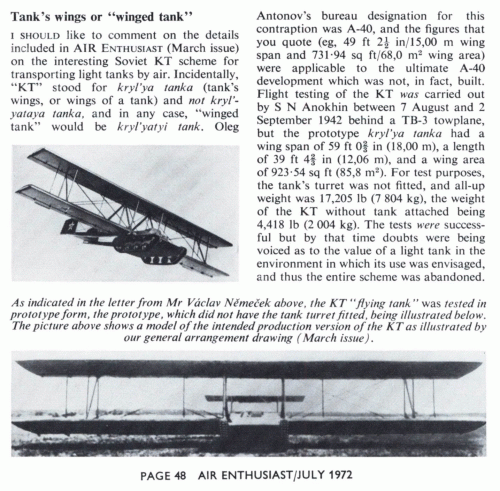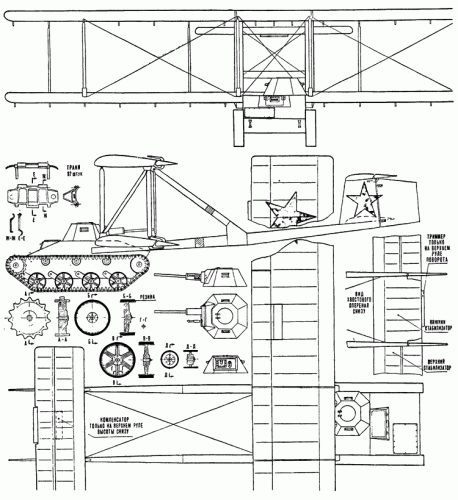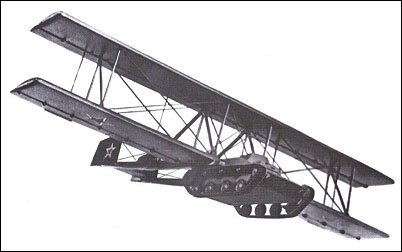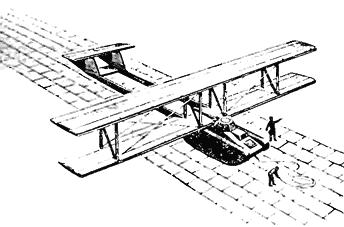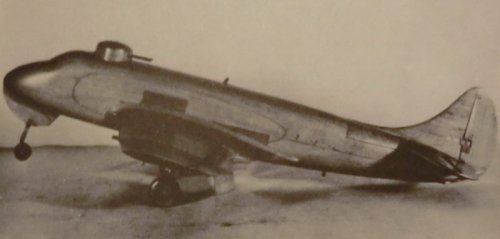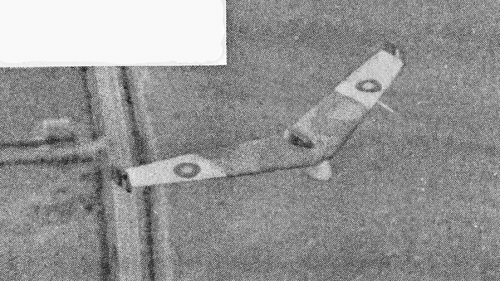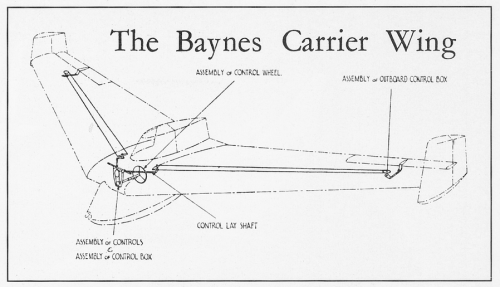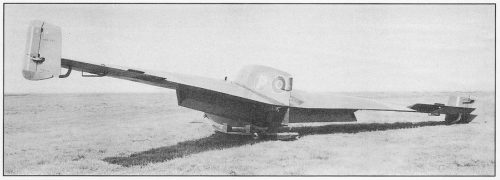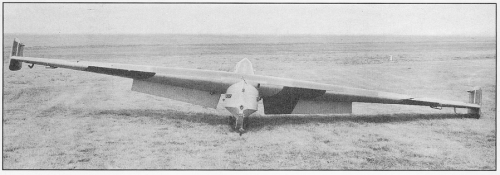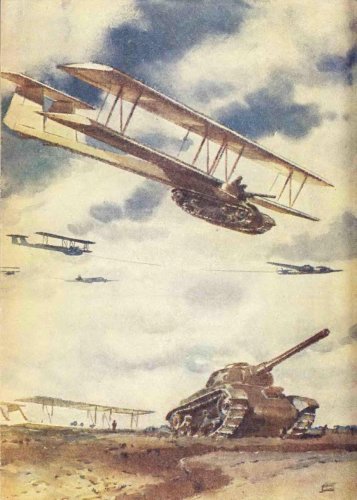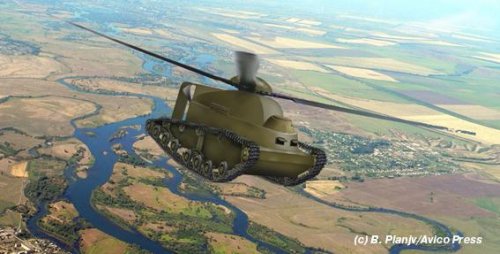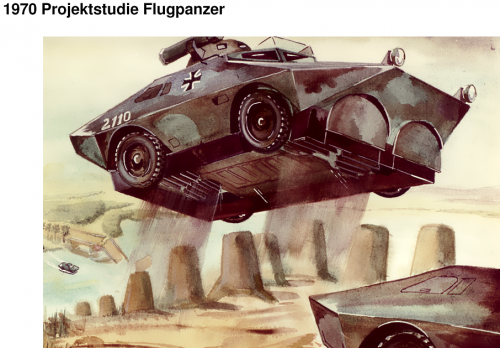You are using an out of date browser. It may not display this or other websites correctly.
You should upgrade or use an alternative browser.
You should upgrade or use an alternative browser.
Flying Tanks
- Thread starter TsrJoe
- Start date
Or put another way...


- Joined
- 11 March 2006
- Messages
- 8,625
- Reaction score
- 3,804
The book is available here:
http://www.buchhandel.de/detailansicht.aspx?isbn=978-3-89574-531-7
Not too expensive, will try to get it. The idea of a flying APC isn't new, but here it seems to
me, that the inventor just had browsed through equipment catalogues and put a lot of things
into his shopping basket, without any thought about the resulting weights. Ok, this can happen
to any amateur, but as an officer expert for international security, he shouldn't be one. And the
guys from the patent office perhaps should have had a closer look, too.
http://www.buchhandel.de/detailansicht.aspx?isbn=978-3-89574-531-7
Not too expensive, will try to get it. The idea of a flying APC isn't new, but here it seems to
me, that the inventor just had browsed through equipment catalogues and put a lot of things
into his shopping basket, without any thought about the resulting weights. Ok, this can happen
to any amateur, but as an officer expert for international security, he shouldn't be one. And the
guys from the patent office perhaps should have had a closer look, too.
Lauge
ACCESS: Secret
- Joined
- 30 January 2008
- Messages
- 434
- Reaction score
- 55
Jemiba said:And the guys from the patent office perhaps should have had a closer look, too.
Well, yes, but compared to the patents out there for anti-gravity flying saucers and free-energy devices, this looks downright well thought out and realistic
Regards & all,
Thomas L. Nielsen
Luxembourg
It would be possible to make a "flying APC," but in order to make a *practical* flying APC, the flight capability would probably have to be a one-time system, shucked the moment it's on the ground. Think of it as a jetpack, but using a modified and updated Pegasus. What would be good is if the "jetpack" has enough smarts that after being removed from the APC, it flies itself back to base for refurb.
But the whole idea is highly steeped in silly.
But the whole idea is highly steeped in silly.
- Joined
- 11 March 2006
- Messages
- 8,625
- Reaction score
- 3,804
Yes, I must admit: I was in the States Library again, browsing foliants of old magazines,
like those of the french "Aviation Magazine" (here the January 1960 issue), presenting a
flying tank design by J.Perard from about the same time as the Antonov KT:
like those of the french "Aviation Magazine" (here the January 1960 issue), presenting a
flying tank design by J.Perard from about the same time as the Antonov KT:
Attachments
- Joined
- 9 October 2009
- Messages
- 21,969
- Reaction score
- 13,615
A couple of years back, Mole dug up the US 1946 'Baker Tank' proposal.
- Joined
- 25 June 2009
- Messages
- 14,752
- Reaction score
- 6,141
Grey Havoc said:A couple of years back, Mole dug up the US 1946 'Baker Tank' proposal.
You are linking a page that shows no image and whose links lead nowhere... Hard to know what that "Baker Tank" was supposed to look like... :-\
here is said "tank' http://www.warwheels.net/Baker8x8JumpingTankIndex.html
If you want more information, then you might want to contact Baker Manufacturing.
http://www.bakercasting.com/AboutUs.html
I did at age 15 more than 40 years ago when a local paper wrote about the Baker Jumping Tank.
They were most kind in sending a report with pictures (sadly long gone).
They did build a test rig (one corner suspension).
For the crew, the ride would probably have been more dangerous than the enemy shells.
http://www.bakercasting.com/AboutUs.html
I did at age 15 more than 40 years ago when a local paper wrote about the Baker Jumping Tank.
They were most kind in sending a report with pictures (sadly long gone).
They did build a test rig (one corner suspension).
For the crew, the ride would probably have been more dangerous than the enemy shells.
- Joined
- 9 October 2009
- Messages
- 21,969
- Reaction score
- 13,615
Stargazer2006 said:You are linking a page that shows no image and whose links lead nowhere... Hard to know what that "Baker Tank" was supposed to look like... :-\
Ack! I knew that the X-Planes forum links needed to be updated, but I wrongly assumed that the DTIC links were still valid. Sorry, should have checked. I'll see what I can do. :-[
EDIT: Here's the updated DTIC link to the full "Transportation Equipment and Related Problems." report, along with the citation, in case you want to order a hard copy. The Baker Tank and and it's proposed carrier should be covered on (PDF) pages 276-280.
My ISP is acting up at the moment, so I can't confirm yet that it is in the exact same layout as before. Also, please note the citation seems to still have the outdated DTIC handle for the main document.
EDIT2: Here's a link to the original X-Planes forum thread, unfortunately you have to be a X-Forum member to view the pictures!
Taranov
ACCESS: Confidential
- Joined
- 23 January 2011
- Messages
- 119
- Reaction score
- 43
W
Wingknut
Guest
Those are wonderful finds, Taranov - many, many thanks for sharing. Maybe you could link this thread to the 'ramming tank' you showed us - I may have got this wrong but, if I read the drawings right, the ramming tank seems to have been designed to leave the ground too and even had propellors to help it through the air.
Anyway, they are all amazing designs. Cheers, 'Wingknut'.
Anyway, they are all amazing designs. Cheers, 'Wingknut'.
- Joined
- 13 August 2007
- Messages
- 8,445
- Reaction score
- 10,996
thx for jumping tank picture, Taranov

but why look this so familiar ?
oh yes this

Nope this is not a Flying Tank proposal, but flying tank from german Sci-Fi pulp series "Perry Rhodan" :
by the way i found a orphaned thread about German Flying tank "the Blue Peacekeeper"
http://www.secretprojects.co.uk/forum/index.php/topic,10218.msg95770.html#msg95770
shall we merge it with this Flying Tanks thread ?
Topics merged
but why look this so familiar ?
oh yes this

Nope this is not a Flying Tank proposal, but flying tank from german Sci-Fi pulp series "Perry Rhodan" :
by the way i found a orphaned thread about German Flying tank "the Blue Peacekeeper"
http://www.secretprojects.co.uk/forum/index.php/topic,10218.msg95770.html#msg95770
shall we merge it with this Flying Tanks thread ?
Topics merged
- Joined
- 11 March 2006
- Messages
- 8,625
- Reaction score
- 3,804
Taranov said:Little O/T
In what section i can post information about WWII unknown aircraft armament?
Found something in artillery documents
If it wasn't actually built, I think the "Early Aircraft Projects" section is ok, if it was built,
but just escaped the public eye still yet, the "Aerospace" section would be more appropriate.
martinbayer
ACCESS: Top Secret
- Joined
- 6 January 2009
- Messages
- 3,397
- Reaction score
- 3,904
Michel Van said:by the way i found a orphaned thread about German Flying tank "the Blue Peacekeeper"
http://www.secretprojects.co.uk/forum/index.php/topic,10218.msg95770.html#msg95770
shall we merge it with this Flying Tanks thread ?
Is that thread generally accessible?
Martin
- Joined
- 13 August 2007
- Messages
- 8,445
- Reaction score
- 10,996
this flying tank landed just here http://www.secretprojects.co.uk/forum/index.php/topic,724.msg95766.html#msg95766martinbayer said:Michel Van said:by the way i found a orphaned thread about German Flying tank "the Blue Peacekeeper"
http://www.secretprojects.co.uk/forum/index.php/topic,10218.msg95770.html#msg95770
shall we merge it with this Flying Tanks thread ?
Is that thread generally accessible?
Martin
martinbayer
ACCESS: Top Secret
- Joined
- 6 January 2009
- Messages
- 3,397
- Reaction score
- 3,904
Hmmm... the original link for the Blue Peacekeeper still doesn't work though.
Martin
Mod
threads were merged, the "Blue Peacekeeper" can be found here
http://www.secretprojects.co.uk/forum/index.php/topic,724.msg95766.html#msg95766
Martin
Mod
threads were merged, the "Blue Peacekeeper" can be found here
http://www.secretprojects.co.uk/forum/index.php/topic,724.msg95766.html#msg95766
- Joined
- 26 May 2006
- Messages
- 34,894
- Reaction score
- 15,758
Attachments
- Joined
- 18 March 2008
- Messages
- 3,529
- Reaction score
- 978
hesham said:Was this a real flying tank (TTP) ?.
Nah, the real one had a Sparrow SARH missile capability. ;D
hesham said:Was this a real flying tank (TTP) ?.
It's a rather amateurish kitbash of an M-113 and an OV-10 Bronco wings/booms/tail, with I *think* a Bear engine. Whoever did this didn't even bother to fair over the front of the OV-10 booms. Feh.
- Joined
- 21 May 2006
- Messages
- 3,002
- Reaction score
- 2,278
Abraham Gubler said:hesham said:Was this a real flying tank (TTP) ?.
Nah, the real one had a Sparrow SARH missile capability. ;D
Regards
Pioneer
- Joined
- 26 January 2011
- Messages
- 2,226
- Reaction score
- 645
hesham said:Was this a real flying tank (TTP) ?.
No, its a proposal by the (in)famous Mike Sparks who believes that the M113 is the answer to all things. :
- Joined
- 25 June 2009
- Messages
- 14,752
- Reaction score
- 6,141
Pelzig
ACCESS: Secret
- Joined
- 23 October 2008
- Messages
- 448
- Reaction score
- 82
It amazed me that the Japanese spent the time and effort on the Maeda Ku-6 glider and So-Ra tank (the combo together called the Kuro-Sha). Clearly, the other major combatants saw no value in winged tanks and did not pursue it.
tom! said:Hi.
r16 said:does this site have English translation ? Checked it a bit but couldn't see if there was
There is no English version of my website or a translation available yet. But all informations in my article on the Ku-Ro or So-Ra flying tank were taken with permission from Taki´s IJA website and a discussion with him on the old "Pacific War 1941-1945"-Board which is no longer available. Maybe you can contact him on the axis history forum.
I recently removed all pics from my website due to a copyright check.
A translation of the article:
"In 1943 the development of an airborne tank started which should be transported as a glider by service aircraft. After landing wings and tail should be detracted and the vehicle should support the airborne troops as light tank. Steering and handling during the air transport were the main problems. It is not known which development stages were reached. At least one wooden mock-up was built but there are no indications for the production of a prototype.
Several questions were probably not solved:
- How to start a tracked vehicle without supporting wheels or a sledge?
- How to steer such a vehicle during flight?
- How to detract the attached elements?
With introduction of the Ku-7 transport glider which was able to transport the type 98 and type 2 light tanks intended as light airborne tanks the glider tank became redundant."
Yours
tom!
- Joined
- 11 March 2006
- Messages
- 8,625
- Reaction score
- 3,804
Hikoki1946 said:It amazed me that the Japanese spent the time and effort on the Maeda Ku-6 glider and So-Ra tank (the combo together called the Kuro-Sha). Clearly, the other major combatants saw no value in winged tanks and did not pursue it.
The value all those nations looked for, was to deliver a tank via aircraft. And at least on first glance, the "flying tank", like
the Russian KT or Japanese Kuro-Sha looks like a more economic solution than a transport glider like the Me 321, or
Hamilcar, which principally would have to be considered as "disposable".
- Joined
- 12 July 2008
- Messages
- 394
- Reaction score
- 148
The late war idea for Japanese flying tanks was to have them land on American airfields, and then shoot up the endless rows of parked American aircraft. This was actually a pretty good idea since gliders would arrive near silently and might take the local defenses by surprise, which would then have a rather hard time dealing with them quickly. Pure suicide, but so what for the Japanese military? The main problem is how slow the tow aircraft is going to be lugging such a glider, but that never stopped any other combat glider use.
At least one a Japanese bomber loaded with suicide commandos did get onto a US airfield, the men plus the cross fire directed against them destroyed or damaged several dozen aircraft. If a light tank had rolled out instead, you'd expect a much worse result for the defenders.
At least one a Japanese bomber loaded with suicide commandos did get onto a US airfield, the men plus the cross fire directed against them destroyed or damaged several dozen aircraft. If a light tank had rolled out instead, you'd expect a much worse result for the defenders.
- Joined
- 11 March 2006
- Messages
- 8,625
- Reaction score
- 3,804
- Joined
- 1 May 2007
- Messages
- 2,595
- Reaction score
- 1,965
From 'Aeroplane Monthly, May 1990, pp. 266-267 :-
"In 1941 the designer L.E.Baynes made a proposal that... the '81/2 ton tank' could be provided with detachable wings to enable them to be flown into battlefields...
The military advantages of of such mobility...were self-evident...In the Baynes proposal... the tank replaced the fuselage and undercarriage, and there was no tail, saving weight...
The glider...would make free landing, the tank's engine being started while still airborne...The wing would be attached by a quick-release device...then carried away by it's residual lift, allowing the tank to go straight into action.
While the Air Staff approved, it was thought wise to proceed first with a 'scale model'.
This machine,...the 'Bat' was designed by Baynes and built by Slingsby's...in 1943. Built of wood, it was aerodynamically similar to the full sized 'carrier wing', but with a small nacelle for the pilot.
Control was by elevons and wingtip rudders. Split flaps were fitted, but no airbrakes. Take-off was from a pair of wheels, and landing on a skid. The serial RA808 was allotted.
The Bat made it's first flight from...Sherbourne-in-Elmet, Yorkshire, in July 1943. Most of the test flights were made by then Flt Lt Robert Kronfeld (the famous pre-war Austrian sailplane pilot), revealing excellent flight characteristics. However, despite the tests showing that the 'Carrier Wing' was feasible, it was not proceeded with because a suitable tank was not available. Also, the decision was taken to develop conventional gliders, which could carry other equipment in addition to tanks.
However, as the Bat was the first 'modern' tailless monoplane fitted with flaps to be available for research...it was fitted with a variety...of instruments and flown extensively by the RAE to obtain data on the stability and control of tailless aircraft."
Does anyone have any more information on the full-sized 'Carrier Wing'? Any ideas as to what the '81/2 Ton Tank' was to be?
Also, there's another Baynes Bat thread on SPF somewhere, but I can't find it...maybe the Mods can and merge it here...?
cheers,
Robin.
"In 1941 the designer L.E.Baynes made a proposal that... the '81/2 ton tank' could be provided with detachable wings to enable them to be flown into battlefields...
The military advantages of of such mobility...were self-evident...In the Baynes proposal... the tank replaced the fuselage and undercarriage, and there was no tail, saving weight...
The glider...would make free landing, the tank's engine being started while still airborne...The wing would be attached by a quick-release device...then carried away by it's residual lift, allowing the tank to go straight into action.
While the Air Staff approved, it was thought wise to proceed first with a 'scale model'.
This machine,...the 'Bat' was designed by Baynes and built by Slingsby's...in 1943. Built of wood, it was aerodynamically similar to the full sized 'carrier wing', but with a small nacelle for the pilot.
Control was by elevons and wingtip rudders. Split flaps were fitted, but no airbrakes. Take-off was from a pair of wheels, and landing on a skid. The serial RA808 was allotted.
The Bat made it's first flight from...Sherbourne-in-Elmet, Yorkshire, in July 1943. Most of the test flights were made by then Flt Lt Robert Kronfeld (the famous pre-war Austrian sailplane pilot), revealing excellent flight characteristics. However, despite the tests showing that the 'Carrier Wing' was feasible, it was not proceeded with because a suitable tank was not available. Also, the decision was taken to develop conventional gliders, which could carry other equipment in addition to tanks.
However, as the Bat was the first 'modern' tailless monoplane fitted with flaps to be available for research...it was fitted with a variety...of instruments and flown extensively by the RAE to obtain data on the stability and control of tailless aircraft."
Does anyone have any more information on the full-sized 'Carrier Wing'? Any ideas as to what the '81/2 Ton Tank' was to be?
Also, there's another Baynes Bat thread on SPF somewhere, but I can't find it...maybe the Mods can and merge it here...?
cheers,
Robin.
Attachments
Sea Skimmer said:The late war idea for Japanese flying tanks was to have them land on American airfields, and then shoot up the endless rows of parked American aircraft. This was actually a pretty good idea since gliders would arrive near silently and might take the local defenses by surprise,
This would work once, and then the Americans would have issued antitank weapons to airfield security. It'd be rather expensive to develop this tank and then only to be able to use it once.
- Joined
- 11 March 2006
- Messages
- 8,625
- Reaction score
- 3,804
Hobbes said:This would work once, and then the Americans would have issued antitank weapons to airfield security. It'd be rather expensive to develop this tank and then only to be able to use it once.
Could be comparable to the planned attack on the Panama locks. Attacking several airfields at the same time, or at least
in quick succession, could have brought a break to a US offensive and so a breathing pause for Japanese. And it would have
tied additional troops and weapons to those airfields, which would have otherwise been used to attack the next island.
- Joined
- 12 July 2008
- Messages
- 394
- Reaction score
- 148
Japanese war planning and strategy was pretty heavily focused on trying to win everything in one swift move. Over and over gain they tried this, see say operation I-Go in which they thought one brilliant air offensive for a few days would turn around the entire situation in the Solomon Islands. This is just how they were, and why Japan launched such a stupid war and then lost it so horrifically in the first place. Look at the entire Type A Midget Submarine program for another example of a one shot niche weapon they spent a huge amount of effort on.
- Joined
- 3 June 2006
- Messages
- 3,094
- Reaction score
- 3,961
Painting Projektstudie FlugpanzerJemiba said:Even in the mid-sixties, the HFB (Hamburger Flugzeug Bau) designed
a lightly armoured, hoverable recce vehicle, based on the lift-fan research
during this time.
(from "Bilderchronik HFB")
Source: http://www.fzt.haw-hamburg.de/pers/Scholz/dglr/hh/text_2008_10_09_HFB320.pdf
Attachments
Similar threads
-
-
-
-
-
Général Keller's 1939 French tank program vehicles
- Started by Elan Vital
- Replies: 33


